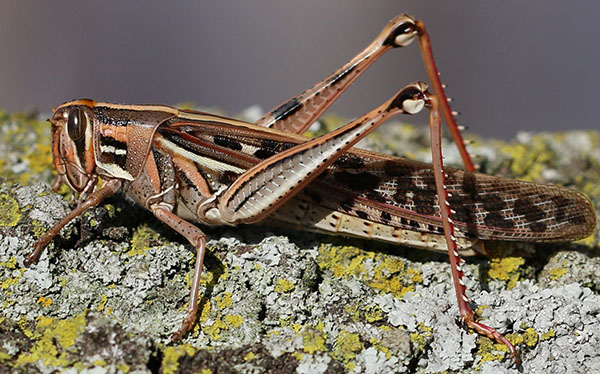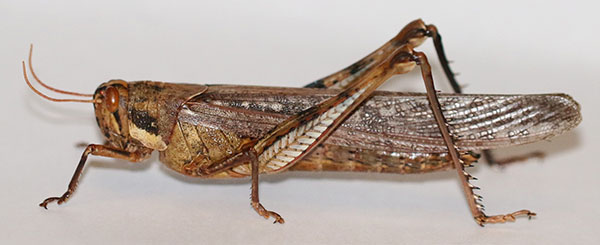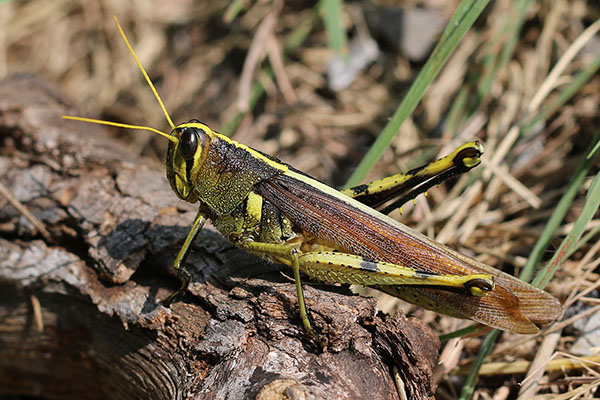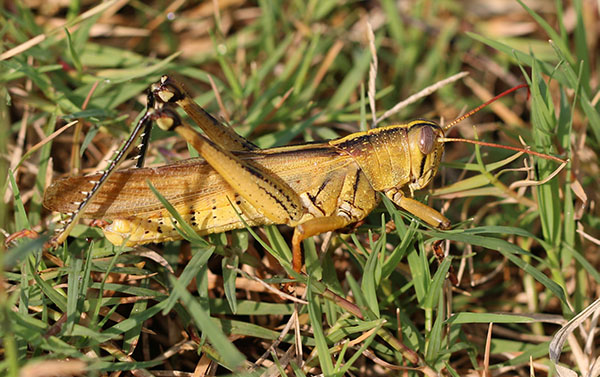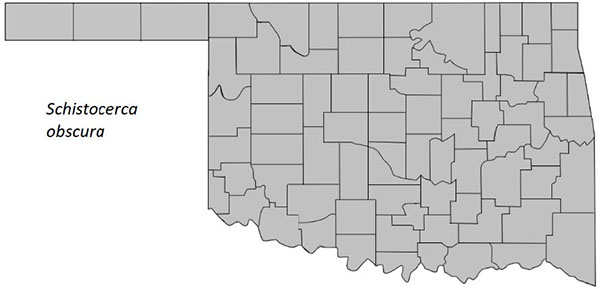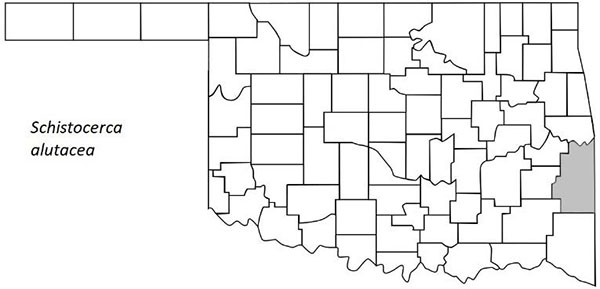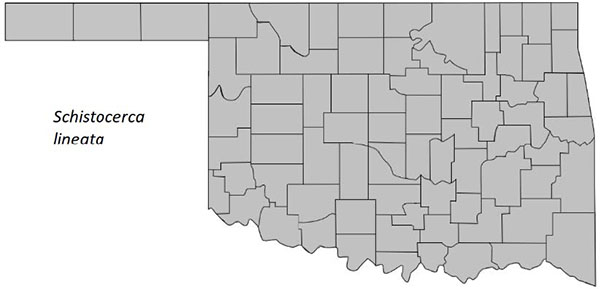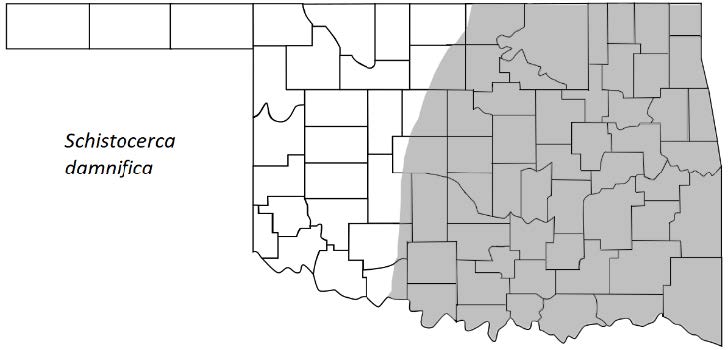Oklahoma’s Bird Grasshoppers
The bird grasshoppers are among the largest species of grasshoppers with short antennae (short-horned grasshoppers). Their bright colors and long-distance flights occur throughout Oklahoma. These grasshoppers feed on a wide array of garden plants, shrubs and trees making them among the most frequently noticed grasshoppers across the state. Although they lack true swarming characteristics the related locusts of Africa possess, they can occasionally become pests of orchards and rangeland. This fact sheet describes how to identify the six species found in Oklahoma as well as other information about these conspicuous insects.
Identification
Adults
Bird grasshoppers are closely related to the spur-throated grasshoppers and likewise have a spur/spine on the underside of the thorax, directly behind their head (Figure 1).
They are substantially larger than most spur-throated grasshoppers. Adults range in size between 1.6 to 2.8 inches (40 to 70 mm) long. They are slender grasshoppers with long wings. Adults generally possess a light-colored dorsal stripe extending from the front of the head through the forewings along the grasshopper’s back (Figure 2).
Another characteristic of bird grasshoppers is the mesosternal lobes on the underside of the thorax are longer than they are wide (Figure 3).The six species found in Oklahoma can be differentiated as follows:
American bird grasshopper, Schistocerca americana: Orange-brown to reddish-brown with obvious dark spotting on the forewings (Figures 4 and 5). White stripes on the forewings, pronotum and head are distinct.
Gray bird grasshopper, Schistocerca nitens: Brownish-gray overall, lacking the distinct patterns of S. americana (Figure 6). Adults have one light bar on the side of the pronotum.
Obscure bird grasshopper, Schistocerca obscura: Olive green body with contrasting brown forewings (Figure 7). Adults with a bright yellow stripe extending along back, dark bars on the hind femur and dark hind tibia.
Leather-colored bird grasshopper, Schistocerca alutacea: Very similar to S. obscura with olive body and brown wings. Only reliably separated by examining the genitalia, but generally with plain hind femur and light hind tibia.
Plains bird grasshopper, Schistocerca lineata: Similar to S. obscura but more variable in color, ranging from brown to green with a bright yellow and black aposematic form found in Texas. Unlike S. obscura, there is generally little contrast between the body and the forewings. Adults often have pale speckling on the pronotum (Figure 8).
Figure 1. S. obscura showing the throat spur characteristic
of spur-throated and bird grasshoppers.
Figure 2. S. damnifica showing the light dorsal stripe typical
of adult Schistocerca.
Mischievous bird grasshopper, Schistocerca damnifica: Uniformly brown overall with a cream-colored dorsal stripe (Figure 9). Adult females have much shorter wings than males and are flightless, which is unique among our Schistocerca(Figure 10).
Figure 3. The elongate mesosternal lobe found in Schistocerca. Illustration by Emerson Harman.
Figure 4. Male S. americana, an orange-brown individual, note the white stripes on the head,
pronotum and forewings.
Figure 5. Female S. americana, a reddish-brown individual.
Figure 6. Female S. nitens, note the pale bar on the side of the pronotum.
Figure 7. Female S. obscura, note olive-green body contrasting with brown wings, as well as
the bright yellow dorsal stripe.
Figure 8. Female S. lineata, note the overall uniform coloration. The dorsal stripe is duller
than in S. obscura.
Figure 9. Male S. damnifica in a typical woodland-edge environment.
Figure 10. Female S. damnifica, note how the abdomen extends beyond the wings.
Nymphs
Usually pale green or brown, often with a dark stripe extending down below the eye. As in adults, nymphs can be identified by examining the mesosternal lobes.
Distribution and Habitat
The ranges of the six species of Schistocerca found in Oklahoma are discussed below. As most Schistocerca species are strong fliers, they have scattered records from outside their typical ranges.
- S. americana: Most abundant in the southeastern quad-rant of the U.S., regularly found as far west as eastern New Mexico and as far north as Nebraska, extending to New York in the northeast. Occurs throughout Oklahoma, but rare in the Oklahoma Panhandle counties (Beaver, Cimarron and Texas). Found in a variety of open, savanna and forested habitats.
- S. nitens: A southwestern species, ranging from Texas and Oklahoma through the central valley of California. In Oklahoma it is mostly restricted to the Panhandle counties. Found in a variety of savanna habitats, often associated with trees or shrubs.
- S. obscura: Similar to S. americana, it ranges from the southeast through Maryland, westward to New Mexico and north to Nebraska. Occurs throughout Oklahoma. Another generalist of open areas, it is most abundant in the southern Great Plains.
- S. alutacea: Found in eastern U.S. from Florida to Missouri and in Michigan and Pennsylvania. Collected only in LeFlore county Oklahoma.
- S. lineata: Throughout the U.S., absent from only the southeast and the northern plains states. Occurs throughout Oklahoma. Usually associated with sandy soils in the eastern portion of its range but in the west, it is more of a generalist of open habitats.
- S. damnifica: similar to S.americana. Extending west only to central Oklahoma and Texas and only as far north as southern Illinois and Maryland. This is the most forest-associated species but may be found in rangeland where it borders woodland.
Economic Importance
Bird grasshoppers feed on a wide range of plants including a variety of grasses, herbaceous plants and woody vegetation. They have been noted to feed on crops including citrus, corn, wheat, cotton, oats, peanuts and rye where they occasionally cause economic damage. S. lineata often is found on legumes with varying food preferences throughout its range.
S. americana in particular often causes problems in citrus orchards. During outbreaks, which usually follow warm winters, the grasshoppers can defoliate young trees and other crops. Most of the damage done by Schistocerca is caused by the 3rd to 5th instars, which are typically more gregarious than adults and result in more concentrated damage. It should be noted that extreme environmental conditions can cause species that are typically solitary to occur at much higher densities and behave gregariously. This occurred with S. obscura during the 1930s due to extreme drought. This trait could lead to outbreaks of Schistocerca in the future.
Dispersal and Migration
Grasshoppers flushed out of an area can fly considerable distances, often landing in a nearby tree or shrub. These strong fliers can survive in a variety of habitat types. Many species have scattered records far beyond their typical range (i.e., S . nitens in Nebraska and S. americana in central Wisconsin). A few species exhibit swarming behavior, such as S. americana. These swarms often will fly substantial distances to locate food. During the night, S. nitens has been observed in large numbers in lit areas.
Hatching
Hatching is staggered in the southern parts of many species’ ranges. In Florida, eggs of S. americana hatch after three to four weeks. However, many species spend much more time as an egg in locations where the egg overwinters. S. obscurais noted as staying as an egg for approximately 260 days under natural conditions (eggs laid in September, hatching in May).
Nymph Development
One notable aspect of nymph development in bird grasshoppers is development is affected by crowding. S. americana, under normal conditions has six instars, while nymphs that develop under low densities, may only exhibit five. Coloration in the nymphal stage also is affected by density, with more nymphs being green at low densities and more brightly colored patterns of yellow, orange and black at high densities. Nymphs typically feed in groups as younger instars, becoming more solitary as they age. Development from hatching to adulthood takes approximately 46 to 52 days in S. obscura, with nymphs developing faster at higher temperatures.
Adults and Reproduction
Reproduction in Schistocerca varies throughout their range and among the different species. S. americana is noted as having two broods per year in the southern part of its range, with eggs being laid in the spring and fall. The hatching time of the eggs is staggered and the adults are long-lived, so it is possible to find adults all year long. S. nitens is similar, and in the southern parts of its range is abundant throughout the year. Further north, Schistocerca have a typical one-year lifecycle, with eggs overwintering and the adults dying toward the end of autumn. In S. americana, females are known to oviposit up to three egg clusters, each containing 60 to 80 eggs. S. obscura also deposit multiple clutches but each egg cluster has substantially fewer eggs than the previous one. In S. obscura, females typically mate 18 days after their final molt, then wait another 44 days before oviposition.
Population Ecology
Populations of bird grasshoppers can vary greatly from year to year. One notable trait of bird grasshopper is that some species, such as S. lineata, display density-dependent aposematism, in which nymphs that develop in high densities develop brighter colors and behave more gregariously than those that develop in low densities. This is similar to the behavior in the closely related desert locust, Schistocerca gregaria, of Africa, which gives rise to immense swarms.
Interestingly, the ability to become gregarious and swarm may be found in all Schistocerca if they reach the appropriate densities. During the dust bowl of the 1930s, S. obscura, which is typically not economically important, formed swarms that caused considerable damage throughout the Great Plains. It appears that prolonged extreme weather conditions can cause the normally solitary grasshoppers to form unusually high densities and transition into being migratory. As extreme weather conditions become more frequent and more severe, it is possible migratory locust behavior will develop in species that currently do not display this trait.
Daily Activity
Daily activity of these species has not been studied, but the presence of most Schistocerca species at lights suggests they are active both during the day and at night.





